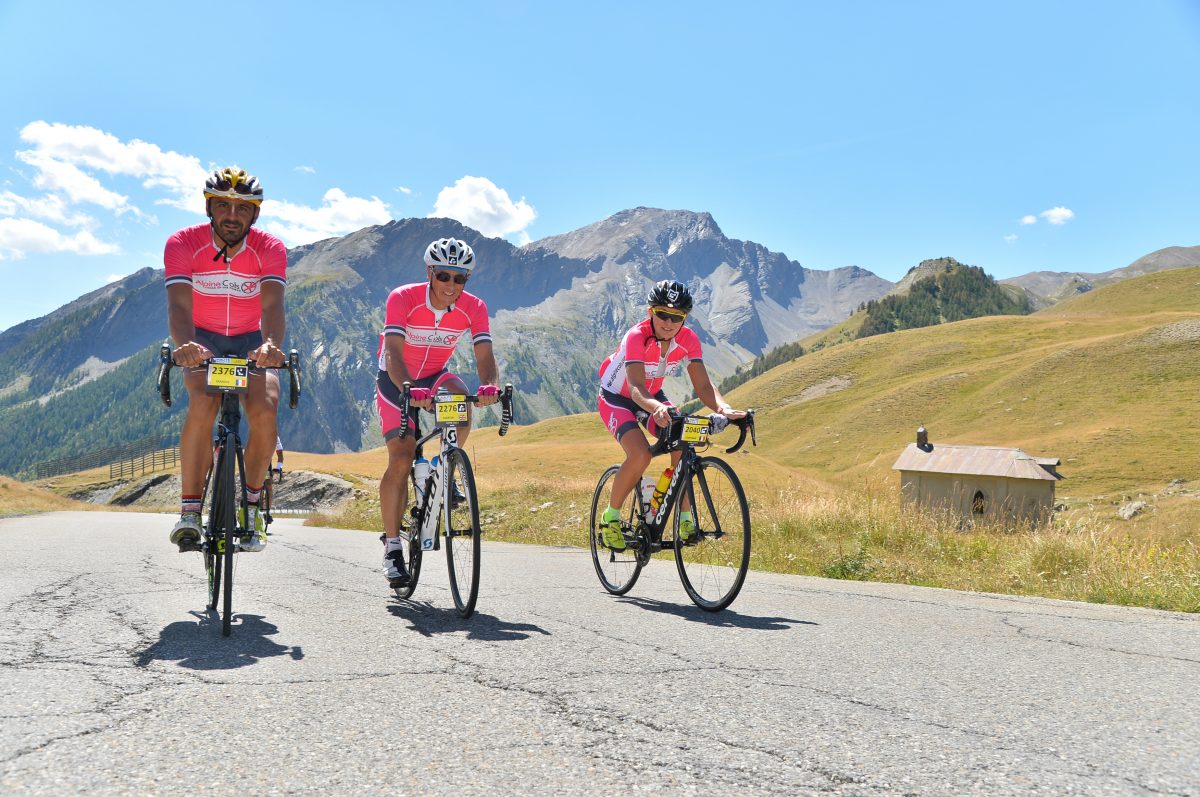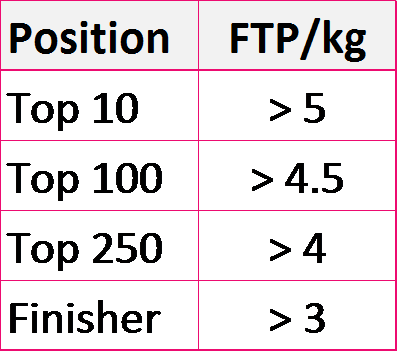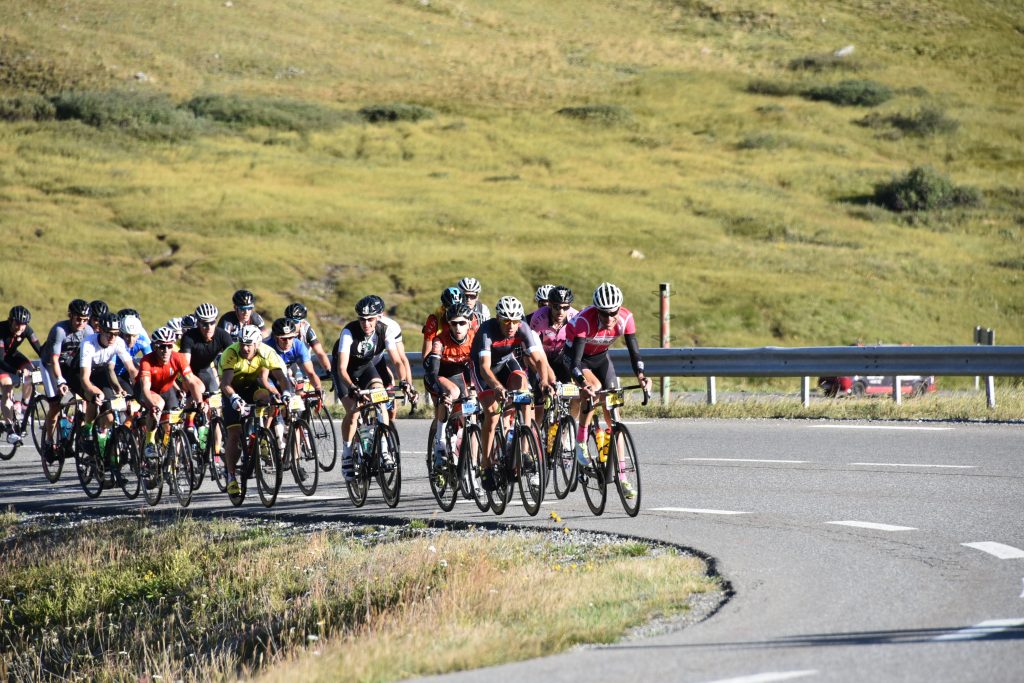
(Updated 13.02.2023)
We have often been asked this question: how much power do I need to ride the Haute Route?
The question is important because the cut-off times can be rather strict. In spite of the organisation’s best efforts the severity of the time limits varies from one event to the next, and even from one day to the next (due to administrative constraints). It is extremely frustrating to be declared a non-finisher due to missing a tight time limit, so our intent here is to provide some data to help you evaluate whether you should be concerned or not.
The answer to how much power you need depends of course on your weight.
The question in fact only makes sense when expressed as watts/kg. Two riders who develop the same average power during a climb but have very different weights will arrive at the top at very different times. The ability to generate 200W during repeated one-hour climbs is more than enough to finish the Haute Route if you weigh 60kg or less, but would not be sufficient if you weigh 100kg. Life is not always fair.
The situation is totally different on the flat where the main resistance comes from the wind, and a heavier rider is not necessarily less aerodynamic than a lighter one. If you have been cycling for a while you will have seen for yourself the difference between relatively heavy, powerful riders that can pull the peloton along like locomotives on the plain, but are quickly overtaken by less powerful but much lighter riders as soon as the road ramps skywards.
One of the key factors that will determine your place in the hierarchy at the end of the week is therefore the power you can put on the pedals throughout the climbs, divided by your weight.
No surprise then, all other things being equal, it is better to lose a couple of kilos than to gain them before the Haute Route, and the more power you can generate, the better!
The climbs at the Haute Route are long and most riders will take at least one hour to finish them (sometimes much longer). For our puposes here, FTP (Functional Threshold Power, defined as the highest average power you can sustain for one hour) is a good proxy for climbing speed when divided by weight.
You may already have a good estimate for your FTP. The best way to determine it is to do the test. Unfortunately this requires a one hour maximum effort, so many people prefer to take short cuts. The most reliable one is to use analytical software to determine your Critical Power (CP) from three shorter efforts (such as 2′, 6′ and 12′). CP is a good proxy for FTP, but may be slightly optimistic. Some people do a 20 minute max effort and then take 95% of this value as their FTP, but this rule doesn’t apply to all, and applying it correctly requires following a specific protocol.
Power requirements for the Haute Route
The following table gives ranges for FTP/kg for riders that finished at various positions in the Haute Route peloton during the period 2014 to 2018. Remember, FTP/kg means the highest average power you can sustain for one hour, divided by your body weight. Be conservative: during the event your actual power will be well below your FTP!

What does this mean for me?
You can’t do anything with these data unless you have your own power data to compare against them. If you have been riding with a power meter for a while, you should have enough data. If you don’t have a power meter, there are still ways to estimate the power you develop (see below).
If you are new to the Haute Route and unsure whether you will be able to finish, the data will either reassure you or suggest the progress you need to make before lining up at the start.
If you are a strong, experienced rider, these data will enable you to situate yourself compared to the riders of the last two years, and thus set realistic objectives for your own participation. For example, if your FTP/kg is 4.5 W/kg, you could reasonably consider a Top 100 objective.
Achieving your objective, however, is another story…
Actual performance in the Haute Route is dependent on a whole range of factors and not just W/Kg. The most important of these are:
- The ability to descend fast and safely (poor descenders can lose large amounts of time on the descents);
- The ability to sustain a high power output over several major climbs per day for 7 days in a row (a stage race is very different to a one-day race).
This last point encompasses a whole range of skills related to race smarts, energy management, nutrition, hydration and recovery and can only be developed through long experience and many hours in the saddle. When we are not working on descending skills, the majority of the time on our coaching camps is focused on these aspects.

What if I don’t have a power meter?
You certainly don’t NEED a power meter either to prepare for or indeed to ride the Haute Route. We think they are a great tool, and we have written elsewhere about the advantages of riding with a power meter.
Power meters are not essential, however, and we acknowledge that many people either don’t want or can’t afford one. In this case, the data given above can still be useful for you:
- If you use Strava, you may have noticed that the site calculates an estimated average power for each segment. So long as you have correctly entered your total weight (body, bike, clothing and equipment, not forgetting your water bottles) this calculation is reasonably accurate on a long climb, so you can use it as a first approximation. If you take 95% of your best ever 20 minute climb, you should be pretty close to your FTP.
- If one of your regular riding buddies has a power meter, you could track him very closely on a long climb. If you take the same time over the same distance your respective FTP/kg should be very close.
- You could also consider borrowing or hiring a power meter for a month and recording your own data.
Definitions
- FTP or Functional Threshold Power is the maximum average power you can sustain for 40-60 minutes. Comparing FTP with another rider (ignoring his weight) will tell you who is more likely to win a time-trial on the flat. Dividing your respective values for FTP by your weights and comparing the resulting values of FTP/kg will tell you who is likely to reach the summit of a long climb first.
If not having a power meter, one can do a FTP test with a Wattbike at local gym
(At least here in Helsinki, Finland we have several possibilities, and at municipal pools and gyms id´s free of charge 🙂 )
Usually the BMI gives a good indication of your hill climbing ability.if your BMI is greater than 21 you would have problems with the Haute Route.
BMI is misleading. A rider 5ft 11 and 81kg has a BMI of 25+. Could have a w/kg of 3.4. Shouldn’t or wouldn’t struggle to finish.